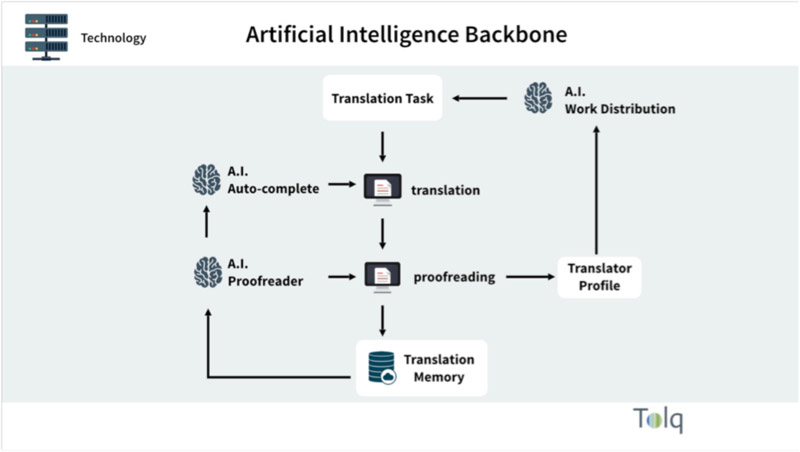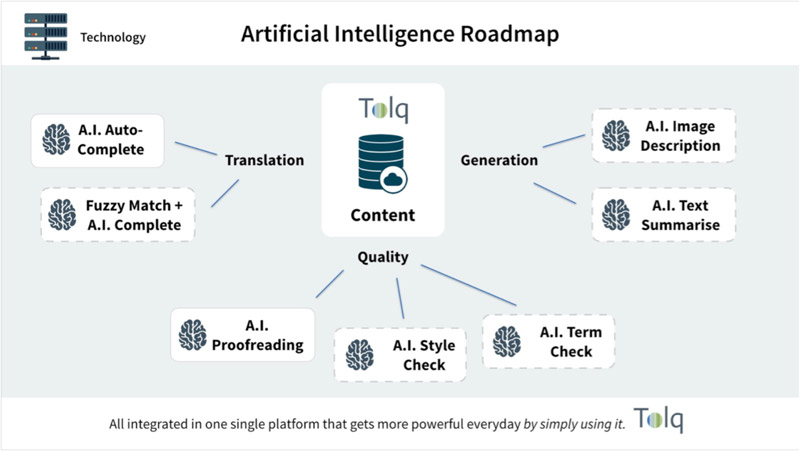The following article was written by Danny de Wit – CEO & Founder of Tolq. Excel Translations does not endorse, recommend, or make representations with respect to its content.
Boom. There it was in the news: Google NMT makes all LSP’s redundant with their Neural Machine Translation efforts! And if not now, then surely within a few years. Neural machine translation solves it when it comes to translation. Right?
Translation industry insiders already know this is not the case, nor is it going to be the case soon. Translation is about understanding, and not just about figuring out patterns, which neural networks do so well. So there are still huge limitations to overcome: homonyms, misspelled source words, consistency, style and tone-of-voice, localization, jargon/terminology, incorrect grammar in the source text and much more.
For now, artificial intelligence is a tool. Just like translation memory and cat tools are. But it’s important to understand that this is a very powerful one and one of a different kind. This is a tool, which when applied correctly, gains strength every day and will open up more and more new opportunities.
Within a period of just a few years, the entire translation industry will be reshaped. Translation is not the only industry where the impact will be felt. The same will go for virtually any industry. The technology is that powerful. But it won’t be in the shape of zero-shot NMT.
Artificial intelligence is a wave of innovation that you have to jump on. And do so today.
Fortunately, it turns out that one key thing to help you do this is one that LSP’s have been doing already for years: collecting high-quality data.
The Key is Data & Algorithms
All A.I. advancements are built upon models that are generated from data-sets. Without data, there is no model. Data is both the enabler, but also the limit. What’s not in the data, is not available to be used.
LSP’s have been collecting data for years and years. Using that data to power A.I. algorithms today and in the future is a key strategy to implement.
In addition, LSP’s have client specific data and add to that data on a daily basis. This means there’s the opportunity to have client specific A.I. tools that gain in strength over time. Offering this to your clients is a big differentiator.
Having generic NMT plus different layers of client specific NMT and other client specific A.I. tools can provide you with workflows that were previously unachievable.
But how do you integrate this inside your operations? We all know that clients and therefore LSP’s have a hard time managing data. The incentive to centralize was always there, but it has never been as clear or impactful as it is right now.

Unification of Workflow, Data Storage and Algorithms: the new holy trinity for LSP’s
The interests of LSP’s and clients are aligned where it comes to the unification of these elements.
Clients can take advantage of huge cost savings and new services (like generated multi-lingual content a.o.).
LSP’s will operate more efficiently and gain huge workflow management advantages.
LSP’s increase on their position as indispensable partners for clients, because of the complexity of the technology involved. Clients will not be able to implement anything like this themselves. In part due to the data + algorithms requirement to make this all work.
Simple workflow improvements, that companies like recently Lilt offer are a step forward, but due to their architecture can only add some efficiency gains inside an existing process, but not lift the LSP organization to a new level taking advantage of all A.I. has to offer.
Instead, architecture that brings together the three key elements to take full advantage of the future is a much better alternative. We call this the “A.I. Backbone” which is present in all our operations. Unifying all workflows and data storage to a central, but still layered, structure. Then add to that different A.I. algorithms to optimize and expand the translation services process.
Architecture that makes your company stronger each day, with each translated word.

New Opportunities: Algorithms Galore!
What can other advances should we expect from A.I. in the near term?
LSP’s can look forward to more advances for workflow optimization and the possibility to introduce new services.
The generic engines will be one of the tools to take advantage of, but to get to the final product that clients require, LSP’s that centralize their operations and data will be able to take advantage of new algorithms to offer clients new services. Some examples are shown in the diagram below. But many more will be made available as the A.I. wave increases in speed.

Value Creation Strategies for LSP’s
When it comes to creating value the core strategy for LSP’s should be to start combining technology with data. Even the technology giants will be envious of that combination. We expect to see huge acquisitions in that space.
In addition, combining data with algorithms can provide powerful scalable profit centers due to their nature. It’s data crunching vs. human workflows.
Leave a Reply